



Chemistry of Oxidative Disinfectants
Oxidative disinfectants share the property of acting on microbes by oxidising their proteins and cells. This aggressive chemical reaction ‘burns up’ and dismembers the very structure of the molecule which is oxidised, thus very effectively destroying target pathogens. (Non-oxidising disinfectants disable pathogens in other ways by modifying their structure but not necessarily completely destroying it).Common oxidative disinfectants include peroxides, peroxygen-persulfate types, Halamid®, peroxide-peracetic acid, and chlorine based disinfectants. While they all share the same mechanism of oxidation, they may differ largely in terms of performance. This article will show different behaviours of oxidative disinfectants in corrosivity and efficacy under soiled conditions.
Corrosion is a significant problem while frequently performing wet disinfection.
Corrosion of for example metal is accelerated by 2 factors: presence of a strong oxidizer and low or high pH. Prolonged use of strong oxidizing formulations of peroxides, peroxymonosulfates and hypochlorite can result in strongly corroded, tarnished and degraded metal equipment in poultry barns (feeders, fans) and around aquacultural premises (pumps, pipes, grilles) including spraying equipment and fogging machines.
France-based Axcentive sarl, producers of Halamid® recently carried out some testing to show the difference of corrosion of various frequently used materials. In this test Halamid® was compared with a permonosulfate based product. For the experiment ASTM norm 1384 was used as basis. In this test the corrosiveness of a liquid can be checked on various substrates at the same time. The liquid chosen were a 1% solution of Halamid®. During the test the liquid is aerated with a constant flux of fresh air.
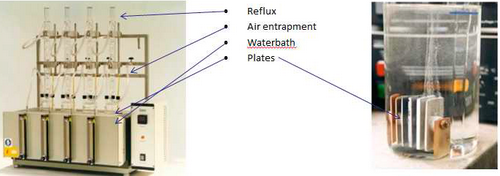
Six different materials underwent the same number of cycles in the disinfectant solution in an open, aerated refluxing vessel. The disinfectant solutions were changed every day to ensure freshness and the results are shown below.
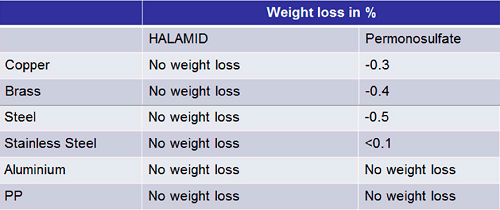
Weight loss measurements provided quantitative proof that Halamid® resists corrosion best, and the images of the corroded metal plates are also revealing in terms of the visual impact of the corrosion.
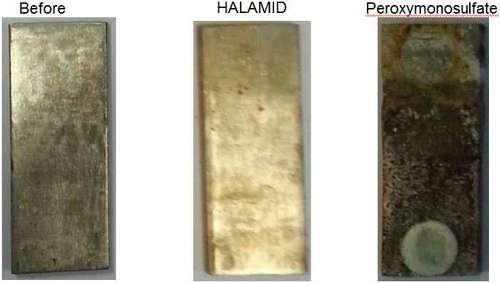
The results here demonstrate that Halamid® disinfectant is less corrosive to metals than peroxymonosulfate type disinfectants, (chosen as the mildest of the two other acidic oxidative disinfectants). It is generally believed the neutral pH of Halamid® and its mild oxidative behaviour vs substrates make that metal or plastics are hardly affected by a Halamid® solution.
Reactivity of disinfectants is another interesting topic. It might be assumed, given the importance of fully oxidising the pathogen, that the more reactive a disinfectant, the better. In reality (and perhaps unsurprisingly) the truth is not so straightforward. The more reactive a disinfectant (or any chemical), the faster it reacts or in other words, the less it is stable. For practical disinfection purposes, manufacturers seek an optimum balance between reactivity (ability to kill pathogens within an acceptable time) and reasonable persistence in real environments where disinfectants are used.
A case in point in which stability is particularly important is disinfection in dirty or soiled conditions. Poultry producers using older buildings, or those who have concerns about thorough dirt removal prior to disinfection, should bear in mind the relative performances of different disinfectant types in dirty conditions. Halamid® and phenolic types might be the best choice.
Dirt, or soil, is a rich and ever-present source of bacterial and fungal growth. Soil from the earth is composed of an inorganic part – containing oxygen, magnesium, sodium, iron, quartz, silicon dioxides, and many other minerals depending on the local geology; and an organic part – of amino acids, proteins, sulphides, nitrogen and phosphorus oxides, and other hydrocarbons. ‘Soiling’ from poultry droppings and waste is of course primarily organic.
When still present, dirt presents a real barrier to effective disinfection because most disinfectants are consumed and hence inactivated by the soil. This is why the industrial standard is of course first to clean prior to disinfection. Despite the best efforts of practitioners however the cleaning process is not always 100% successful. Cracks in cement and joints in steel harbour pernicious dirt. Poultry growing barns in some countries have floors of beatenearth only, and not everywhere has access to high pressure cleaning apparatus. In a study conducted it was shown that up to 20% of soil still remains after the cleaning step.
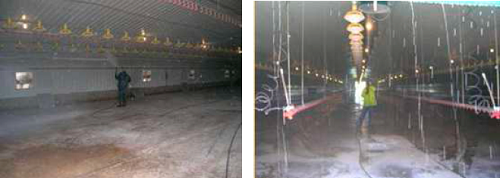
The message is clear: a good disinfectant should be as stable as possible in the presence of soil. Around the world, regulatory standards are catching up to this fact by the increasing importance of efficacy results in the presence of organic soil. Typically, hypochlorite and peroxides / peroxygen formulations are highly affected by soil. The fast-reacting molecules of these biocides are quickly inactivated when they oxidise or react with organic matter; and they are less likely to penetrate the soil far enough to reach and act on pathogens. Phenolic types and the universal disinfectant Halamid® are less affected. Being more chemically stable, they migrate further through a layer of soil, still active and able to destroy pathogens.
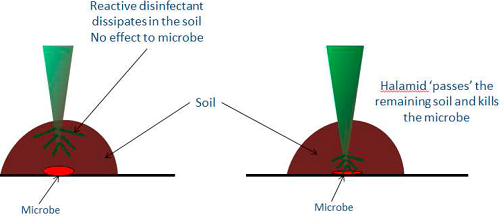
For example, tests have demonstrated the very different stability of two chlorine-containing oxidative disinfectants, hypochlorite and Halamid® in the naturally soiled water of a river. Hypochlorite is almost completely reacted and used up after an hour or so where Halamid® is still more than 90% present as shown below.

Another study has demonstrated that 60% of Halamid® still remains active in soiled water after 24 hours whereas a Peroxygen/Persulfate formulation decreases to 10% activity and Hypochlorite is fully consumed.
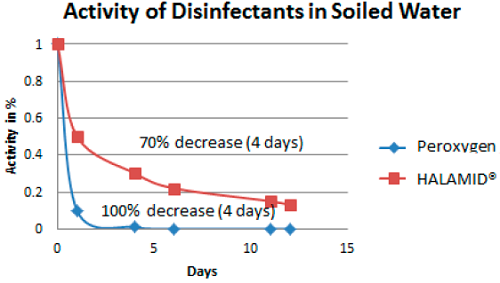
Finally, efficacy testing against various pathogens shows hardly any difference in the dosage of Halamid® required for the same killing effect at low level and high level soiling as shown below;

Whereas most disinfectants need to increase the dosage considerably to pass the test: Another example of the advantage of a relatively stable disinfectant. The corollary of this is that the contact time needed to achieve the same killing affect is often quicker with hypochlorite and peroxygens, than with more stable Halamid® - although all these disinfectants can obviously achieve the killing effect necessary to earn their national regulatory approvals wherever they are marketed.
Axcentive Technical Manager Arno Schut comments on these results: “Of course the ideal advice is clean thoroughly first but I’ve seen a lot of places where practise doesn’t live up to that theory! Halamid® works well in these conditions”.
In conclusion, different disinfectants have different benefits and drawbacks in different situations of usage. This article has hopefully demonstrated that, whether it concerns pH or reactivity, extreme specifications do not necessarily always equate to the best performance!
Further information on Halamid® can be obtained from www.axcentive.com, by emailing
[email protected] or by calling our sales office on +33 442 694 090.









